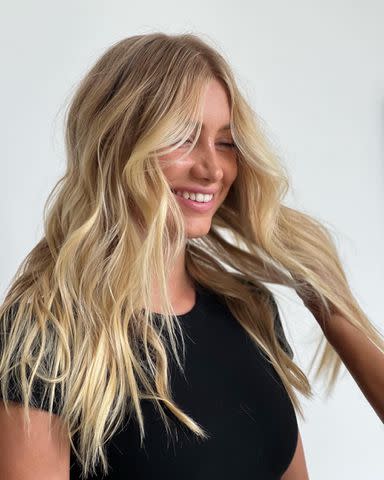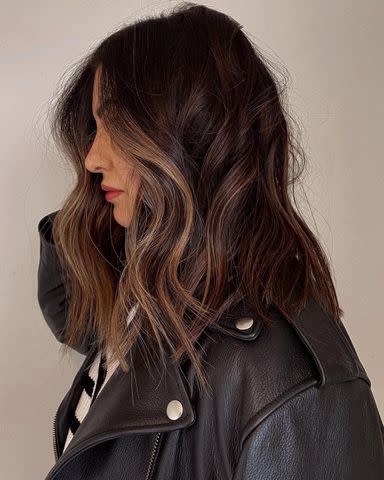Foilyage 101: Everything You Need to Know About the Hybrid Highlighting Technique

@jlo/Instagram
- Oops!Something went wrong.Please try again later.
Foilyage is the most common coloring method I've seen in salons over the last ten years, but we never really had a name for it until recently. It isn't balayage, and it isn't foil highlights; as the name would suggest, it's something in-between. And in most situations, it provides the client with the best of both worlds.
We tapped three expert colorists—Tracey Cunningham, Richy Kandasamy, and Gloria Bonilla—to give us the scoop on what this method is (and isn't), what to expect during your appointment, and so much more. Read on for what they told us.
Meet The Experts
Tracey Cunningham is a celebrity hair colorist whose clients include Kourtney Kardashian and Emma Stone, among others.
Richy Kandasamy is a colorist and R+Co Collective Member.
Gloria Bonilla is a colorist at Sally Hershberger Salons.
What Is Foilyage?
Foilyage combines two types of highlighting techniques for a super-charged brightening effect: balayage and traditional foils. Balayage, which is hand-painted, "is known for its softer, blended look," which only appears on the mid-lengths and ends, explains Kandasamy. Traditional foil highlights are different from balyage in that they offer a more delicately woven brightness that covers strands from roots to ends.
By combining the two, you get hair that is lighter and brighter than a typical balayage but with more of a color lift than hand painting alone can achieve, explains Cunningham. So when the goal is natural, sun-kissed hair color, Kandasamy says foilyage is the popular choice.

@johnnyramirez / Instagram
The Benefits
The main benefit of foilyage is how low maintenance it is. "The color grows out naturally without a stark line of demarcation," Kandasamy says. "Many people can go several months between touch-ups."
The other big perk to this technique is simply getting the best of both worlds between hand-painting and the foil placements. "It'll give you that pop [of brightness] that regular balayage might not be able to do [on its own], especially if you have hard-to-lift hair," says Bonilla.
And if you have naturally darker hair that has a hard time lifting to shades of blonde, Bonilla says foilyage is a safer way to brighten and lighten things with a low-volume developer. "Low and steady wins the race," she adds.
The Drawbacks
While the foilyage application method is generally safe for anyone, it may not be the best choice for everyone, especially when considering pre-existing color. "Foilyage is a versatile coloring technique that can work for many people, but there are some scenarios where it might not be the best fit," says Kandasamy. These include:
DIY color: "People who've used boxed dye or henna should tell their colorist beforehand," says Bonilla, who warns that those with these types of treatments may not be good candidates for foilyage. These types of dyes "will affect the bleach and [cause] a chemical reaction, therefore potentially ruining the integrity of the hair," she explains.
Chemical damage: If your hair is significantly damaged from previous bleaching or lightening treatments, or your hair routine consists of excessive and frequent heat styling, this amount of lightening may not be the best choice for your hair health.
Shorter length: "Foilyage tends to be most effective on medium to long hair lengths," explains Kandasamy. "On very short hair, it can be challenging to create the subtle transitions and dimension that foilyage is best known for."
Heavy highlights: "If a client has hair that is already heavily highlighted, foilyage isn't the best option for them," says Cunningham. "[Their] hair would need to be colored darker first and then lightened." So, it isn't as simple as starting with one color technique (foils or balayage) and moving on to its hybrid successor.
How to Prepare
Before you book a foilyage appointment, you'll need to consult with your colorist. Even if you've been going to them for years, it's important to make sure you've got a clear vision going into this type of treatment.
"It's best if you show up [to your appointment] with clean, dry hair," says Cunningham. This doesn't mean you need to be fresh out of the shower when you arrive at the salon, but perhaps wash it the night before and stay clear of any products. Some colorists will send you straight to the shampoo bowl for a wash and dry if they find your scalp too oily, resulting in additional costs. "Impurities can block the bleach and other materials [and] you won't get as even of a lift," Cunningham explains.
Kandasamy points out that natural oils on the scalp can add a protective barrier to your strands during a color service; however, it is easy for that to be mistaken as having an oily scalp from product build-up or hair that's just a little too dirty. "Different techniques and products have different requirements, so it's essential to follow your colorist's specific instructions," he says.
Learn More: 7 Ways to Prep for a Hair Color Appointment, According to Stylists
What to Expect
If you're going in for foilyage, you can expect to be at the salon for at least 2-3 hours—and to leave with a natural and dimensional head of highlights.
The processing time boils down to length, density, and pre-existing treatments on the hair. If you have a darker natural hair color, it may take more time to lift the hair to the desired level of lightness. If you have extra long hair (or simply a lot of it), you're probably used to the drill by now— your treatment may take a while. Even though Cunningham says the time it takes for the bleach to work is usually in the 35-45 minute range, the application, removal, washing, toning, treatments, drying, and everything else required are what make for the long salon visit.
Depending on the state of your hair, other treatments may be recommended or required. "I always apply the Olaplex Standalone treatment to help repair the hair," Cunningham says of her foilyage clients. After all the foils are removed and the hair is rinsed at the shampoo bowl, Cunningham chooses this type of treatment for her clients (consisting of Olaplex no. 1 and no. 2 for salon professionals only) to rebuild and relink the damaged disulfide bonds in the hair, giving it a stronger and healthier look post-bleaching.

@chrisweberhair /Instagram
How to Maintain
To maintain the vibrancy of your color, prolong its lifespan, and keep your hair's strength intact, you'll need to invest in quality products to use at home. "Purple toning shampoo and conditioner can keep brassiness and dullness away," says Cunningham, who also recommends weekly bond-building treatments to maintain good hair health.
There are plenty of good at-home care practices for foilyage, or any lightening hair treatment, for that matter. Here are the three chief investments to consider making in your color maintenance, according to Kandasamy:
Sulfate-free cleansers: "Use a shampoo and conditioner like R+Co's Gemstone Color Shampoo ($34) and Conditioner ($34)," he suggests. "Sulfate-free products are gentler on colored hair and help prevent premature fading."
Heat protectants: Heat styling tools like flat irons and curling irons can accelerate color fading. Use them sparingly, and always use a heat protectant spray.
Deep conditioning treatments: "The regular application of conditioning masks or treatments will keep your hair healthy and moisturized, which can help preserve your color," he says. "I love R+Co Blue Primary Color Masque ($59)."
"Like balayage, roots stay a bit darker than the rest of the hair, so unless you need a root touch-up for gray hair, foilyage can be touched up every 4-6 months," Cunningham tells us.
The Cost
The average starting rate for foilyage can be anywhere from $250 to $400, but rates can get up to $750, depending on some of the above factors. "The cost of a foilyage color treatment can vary widely depending on factors such as the salon's location, the expertise of the stylist, and the length and thickness of your hair," says Kandasamy.
The Final Takeaway
Foilyage is a popular technique for lightening and brightening the hair. It's a great choice for those with longer lengths and minimal pre-existing treatments, and while the cost can be steep, with the proper at-home care, your salon visits will be few and far between.
Up Next: Balayage vs. Ombré: How to Spot the Differences, Straight From the Pros
Read the original article on Byrdie.

